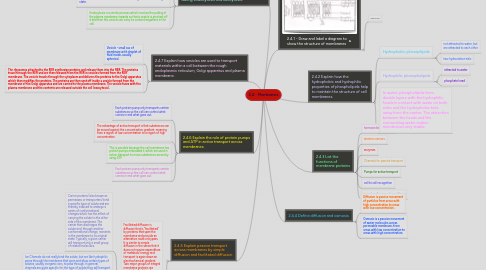
1. 2.4.5 Explain passive transport across membranes by simple diffusion and facilitated diffusion.
1.1. Facilitated diffusion is diffusion that is "facilitated" by proteins that span the membrane and provide an alternative route or bypass. It is similar to simple diffusion in the sense that it does not require expenditure of metabolic energy and transport is again down an electrochemical gradient. Two major groups of integral membrane proteins are involved in facilitated diffusion:
1.1.1. Carrier proteins (also known as permeases or transporters) bind a specific type of solute and are thereby induced to undergo a series of conformational changes which has the effect of carrying the solute to the other side of the membrane. The carrier then discharges the solute and, through another conformational change, reorients in the membrane to its original state. Typically, a given carrier will transport only a small group of related molecules.
1.1.2. Ion Channels do not really bind the solute, but are like hydrophilic pores through the membrane that open and allow certain types of solutes, usually inorganic ions, to pass through. In general, channels are quite specific for the type of solute they will transport and transport through channels is quite a bit faster than by carrier proteins. Additionally, many channels contain a "gate" which is functions to control the channel's permeability. When the gate is open, the channel transports, and when the gate is closed, the channel is closed. Such gates can be controlled either by voltage across the membrane (voltage-gated channels) or have a binding site for a ligand which, when bound, causes the channels to open (ligand-gated channels). Ion channels allow currents to be carried across the membrane and are thus of particular importance in the physiology of excitable cells like neurons and muscle cells.
2. 2.4.8 Describe how the fluidity of the membrane allows it to change shape, break and re-form during endocytosis and exocytosis.
2.1. The phospholipids in the cell membrane are not solid but are in a fluid state allowing the membrane to change its shape and also vesicles to fuse with it.
2.2. This means substances can enter the cell via endocytosis and exit the cell via exocytosis. The membrane then returns to its original state. In exocytosis the vesicles fuse with the membrane expelling their content outside the cell. The membrane then goes back to its original state.
2.3. Endocytosis is a similar process which involves the pulling of the plasma membrane inwards so that a vesicle is pinched off it and then this vesicle can carry its content anywhere in the cell.
3. 2.4.7 Explain how vesicles are used to transport materials within a cell between the rough endoplasmic reticulum, Golgi apparatus and plasma membrane.
3.1. Vesicle - small sac of membrane with droplet of fluid inside, usually spherical.
3.2. The ribosomes attached to the RER synthesize proteins and release them into the RER. The proteins travel through the RER and are then released from the RER in vesicles formed from the RER membrane. The vesicle travels through the cytoplasm and delivers the proteins to the Golgi apparatus which then modifies the proteins. The proteins are then sent off inside a vesicle formed from the membrane of the Golgi apparatus and are carried to the plasma membrane. The vesicle fuses with the plasma membrane and the contents are released outside the cell (exocytosis).
4. 2.4.6 Explain the role of protein pumps and ATP in active transport across membranes.
4.1. Each protein pump only transports certain substances so the cell can control what comes in and what goes out.
4.2. The advantage of active transport is that substances can be moved against the concentration gradient, meaning from a region of low concentration to a region of high concentration.
4.3. This is possible because the cell membrane has protein pumps embedded it which are used in active transport to move substances across by using ATP.
4.4. Each protein pump only transports certain substances so the cell can control what comes in and what goes out.
5. 2.4.3 List the functions of membrane proteins
5.1. hormone binding sites
5.2. electron carriers
5.3. enzymes
5.4. Channels for passive transport
5.5. Pumps for active transport
5.6. cell to cell recognition
5.7. receptors for neurotransmitters
6. 2.4.1 - Draw and label a diagram to show the structure of membranes
6.1. New node
7. 2.4.4 Define diffusion and osmosis.
7.1. Diffusion is passive movement of particles from areas with high concentration to areas with low concentration.
7.2. Osmosis is a passive movement of water molecules across permeable membrane, from areas with low concentration to areas with high concentration.
8. 2.4.2 Explain how the hydrophobic and hydrophilic properties of phospholipids help to maintain the structure of cell membranes.
8.1. Hydrophobic phosopilipids
8.1.1. not attracted to water, but are attracted to each other
8.1.2. two hydrocarbon tails
8.2. Hydrophilic phosopholipids
8.2.1. attracted to water
8.2.2. phosphate head
